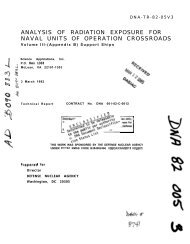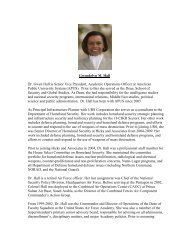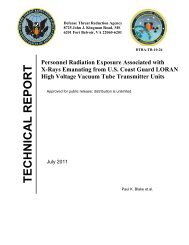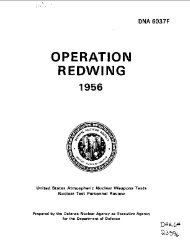Shield - Defense Threat Reduction Agency
Shield - Defense Threat Reduction Agency
Shield - Defense Threat Reduction Agency
Create successful ePaper yourself
Turn your PDF publications into a flip-book with our unique Google optimized e-Paper software.
Command Sgt. Maj. Alston speaking to children during the month of the military Child DtrA/sCC-WmD Color Guard demonstration.<br />
It really wasn’t a policy-driven organization.<br />
It was an organization that implemented the<br />
policies and procedures for dealing with the<br />
White House or their military offices that<br />
were already in place. What the position did<br />
for me personally was teach me that there’s<br />
a greater cause for the military than being<br />
“ground pounders”. When you’re part of<br />
a ground troop, you think about ground<br />
events. You think about what’s happening<br />
right there in that orderly room of the 325th<br />
Infantry. And your mindset is there. You<br />
may grow a little bit to the brigade level,<br />
but other than that, you don’t worry about<br />
how the “Big Army” works, how the other<br />
services work, how everybody fits together,<br />
and how collectively, we became the fighting<br />
machine that we are today.<br />
Working in the Contingency Support Detachment<br />
really gave me a different side of<br />
the Army. It gave me perspective on the<br />
more strategic end and it kind of put me on<br />
another level. I had to look across the armed<br />
forces to understand cultures and to understand<br />
how everybody dealt with different<br />
situations. I had to take all of that knowledge<br />
and really integrate it into one mindset<br />
for the betterment of the nation versus a<br />
mindset of “Just Army.”<br />
When you’re dealing with the president<br />
and his direct staff, you stop thinking bipartisan<br />
and you start thinking inclusive.<br />
You start thinking; “What do civilians do<br />
everyday to help our armed forces? And<br />
how do the contractors support our armed<br />
forces?” You start seeing the “big picture”.<br />
1 / the shield / fall 2011<br />
Starting with the 23rd Chemical Battalion,<br />
you spent several years in South<br />
Korea. How did that experience shape<br />
your current view on CBRNe weapons<br />
worldwide?<br />
Whenever you are forward-deployed in<br />
harm’s way, at any given time, it kind of gives<br />
you a mindset of preparedness. When you’re<br />
in Korea, you’re more prepared than you<br />
would ever be in any garrison situation back<br />
in the U.S. Your thought pattern changes<br />
because you know that, on any given day,<br />
somebody could come across the Korean<br />
demilitarized zone and cause not only harm<br />
to you, but harm to your peers and your<br />
subordinates alike. Therefore, your mindset<br />
for readiness is keyed into each and every<br />
day. You don’t have time to react to every<br />
situation, but you have time to prepare for<br />
situations. So, when it’s time to make sure<br />
that the protective masks and protective<br />
overgarments work, you already know that<br />
they work. There’s no time to think about<br />
them once the enemy attacks.<br />
if you were having lunch with a fellow<br />
CBRNe colleague, how would you describe<br />
your role at DTRA/SCC-WMD?<br />
As you grow up as a CBRNE soldier, you<br />
usually do the minimum when it comes<br />
to doing CBRNE business. You find yourself<br />
either in the 23rd Chemical Battalion<br />
working in the motor pool or in the 2nd<br />
Chemical Battalion dealing with the Foxes,<br />
the nuclear, biological and chemical recon-<br />
naissance vehicles. You find yourself doing<br />
some CBRNE stuff, but not at the micro<br />
level that DTRA/SCC-WMD does it.<br />
The conversation I would have with a<br />
CBRNE colleague is that what we’re doing<br />
here is not something that you can read in<br />
a manual. It’s real-time. And if you really<br />
want to excel in your trade or your business…<br />
if you really want to go out and see<br />
how the world is being kept safer… if you<br />
really want to go see how we’re preparing<br />
our research and development programs<br />
for mission success… and if you’re ready to<br />
learn even more about your field… there’s<br />
no better place to do it than here.<br />
How do you leverage a career’s worth of<br />
CBRNe experience in your role as Command<br />
Senior enlisted Leader at DTRA/<br />
SCC-WMD?<br />
If you look at Director Myers, he came from<br />
a political background. His CBRNE knowledge<br />
and background came largely from the<br />
Nunn-Lugar program that he worked on<br />
with Senator Lugar. But when it comes to<br />
more of a conventional WMD, 20th Support<br />
Command, and the conventional units<br />
around the world, I give the director perspective<br />
at the operational level… how our<br />
armed forces, as a whole, deal with CBRNE<br />
events. I am here to ensure that we don’t<br />
overlook the value of our military forces at<br />
DTRA/SCC-WMD. They are the minority<br />
here, especially our more junior military<br />
workforce, but when you look at our mis-<br />
photo CoUrtesY of CommAnD sGt. mAJ. pAtrICK Alston









